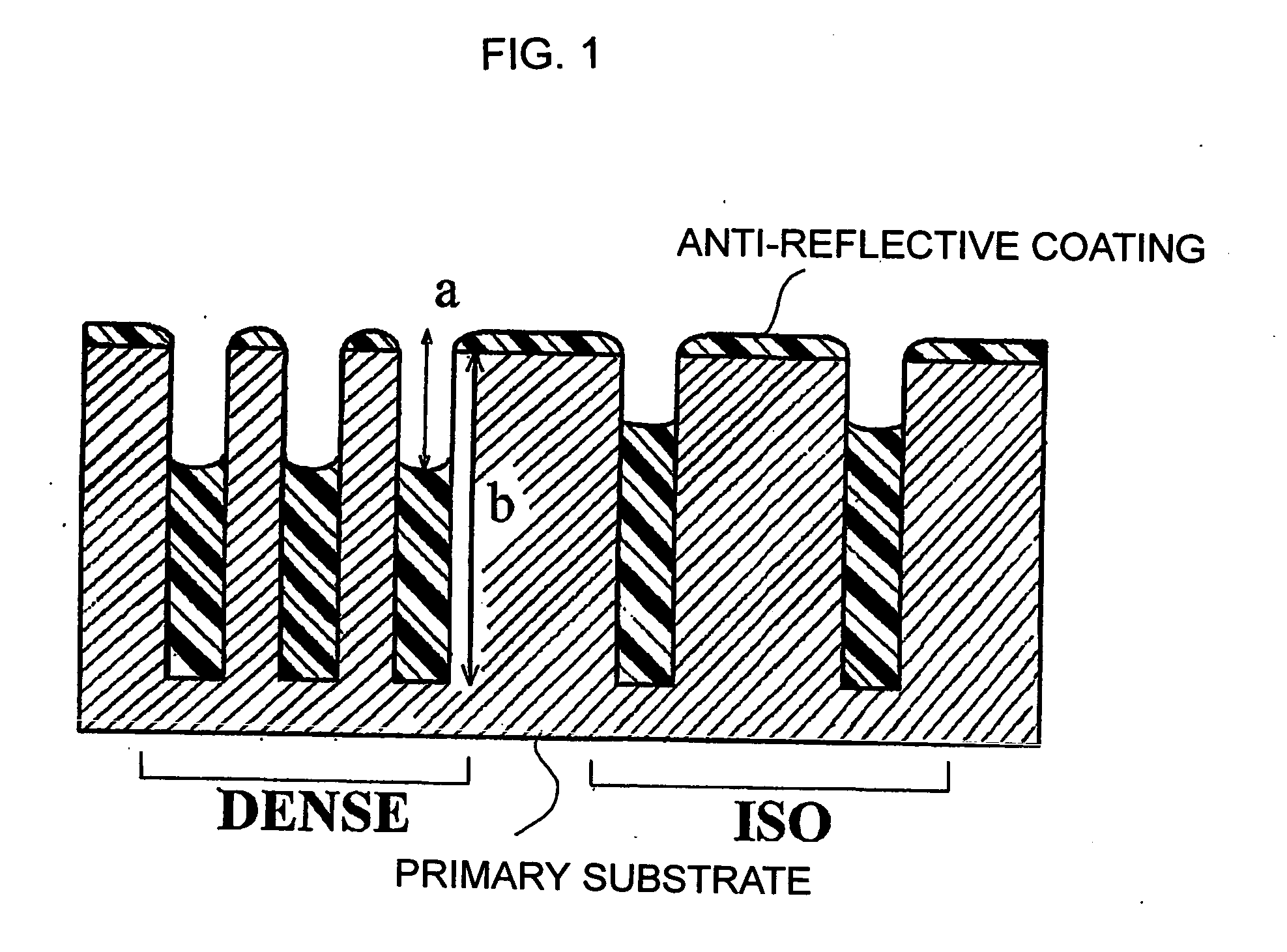Composition for forming anti-reflective coating for use in lithography
a technology of anti-reflective coating and composition, which is applied in the direction of resistive material coating, photosensitive material auxillary/base layer, synthetic resin layered products, etc., can solve the problems of affecting the performance of lithography, and reducing the efficiency of lithography, so as to reduce control the rate of crosslinking reaction , the effect of increasing the dry etching ra
- Summary
- Abstract
- Description
- Claims
- Application Information
AI Technical Summary
Benefits of technology
Problems solved by technology
Method used
Image
Examples
synthesis example 1
A halogen-containing novolak epoxy resin (trade name: BREN-304 manufactured by Nippon Kayaku Co., Ltd.) was prepared. The resin had a weight average molecular weigh of 900 and a structure of formula (14).
After 100.0 g of the halogen-containing novolak epoxy resin was dissolved in 251.3 g of propylene glycol monomethyl ether, 67.6 g of 9-anthracenecarboxylic acid and 1.05 g of benzyltriethylammonium chloride were added. These compounds were reacted at 100° C. for 24 hours to obtain a polymer. The resulting polymer was subjected to GPC analysis and had a weight average molecular weight of 1,900 in terms of standard polystyrene. The structure of the resulting resin was shown by formula (15).
In formula (15), the molar ratio of n8: n5 in the whole polymer was 5:95, and n6 was 1.7.
synthesis example 2
After 26 g of glycidyl methacrylate monomer and 57 g of hydroxypropylmethacrylate were dissolved in 331 g of propylene glycol monomethyl ether to obtain a reaction solution, nitrogen was flowed into the reaction solution for 30 minutes. While the reaction solution was maintained at 70° C., 0.8 g of azobisisobutyronitrile (AIBN) as a polymerization initiator and 0.3 g of 1-dodecanethiol as a chain transfer agent were added therein and stirred under nitrogen atmosphere. After stirring for 24 hours, 0.1 g of 4-methoxyphenol as a short-stop was added therein. The resulting polymer was subjected to GPC analysis and had a weight average molecular weight of 36,400 in terms of standard polystyrene. The solid content in the solution was 20%.
The resulting resin was a copolymer of glycidyl methacrylate with hydroxypropylmethacrylate corresponding to a structure of formula (16), wherein the molar ratio of m: n was 35:65.
To 64 g of the reaction solution containing 6.4 g of the resin obtain...
synthesis example 3
As a reaction solution, 300 g of a polymer solution (manufactured by Lancaster Co., Ltd.) in which p-hydroxystyrene monomer was dissolved in 20% by weight of solid concentration in propylene glycol was prepared. Nitrogen was flowed into the reaction solution for 30 minutes. While the reaction solution was maintained at 70° C., 0.1 g of azobisisobutyronitrile (AIBN) as a polymerization initiator was added therein and stirred under nitrogen atmosphere. The reactant was precipitated again in 1 liter of distilled water and the precipitate was filtered and dried to obtain a polymer in a shape of powder. The resulting polymer was subjected to GPC analysis and had a weight average molecular weight of 21,000 in terms of standard polystyrene. The resulting polymer was poly p-vinylphenol corresponding to a structure of formula (18).
PUM
| Property | Measurement | Unit |
|---|---|---|
| aspect ratio | aaaaa | aaaaa |
| width | aaaaa | aaaaa |
| width | aaaaa | aaaaa |
Abstract
Description
Claims
Application Information
 Login to View More
Login to View More - R&D
- Intellectual Property
- Life Sciences
- Materials
- Tech Scout
- Unparalleled Data Quality
- Higher Quality Content
- 60% Fewer Hallucinations
Browse by: Latest US Patents, China's latest patents, Technical Efficacy Thesaurus, Application Domain, Technology Topic, Popular Technical Reports.
© 2025 PatSnap. All rights reserved.Legal|Privacy policy|Modern Slavery Act Transparency Statement|Sitemap|About US| Contact US: help@patsnap.com



